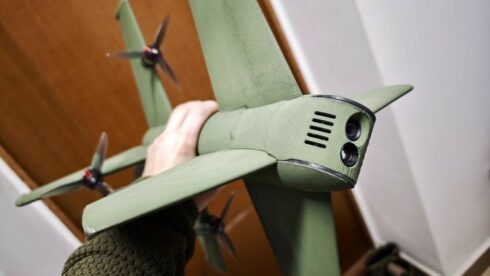The Russian military has begun to use a new man-portable interceptor drone to take down Ukrainian unmanned aerial systems.
The new interceptor, dubbed “Yolka,” features a unique design that companies the qualities of a electric-powered quadcopter with x-shaped fixed wings in a fairly small form factor. The interceptor is also launched from a light handheld device.
While the specification of the interceptor, like its speed and range, remains classified, combat footage that surfaced online on May 19 and later provided some info on how the system operates.
The footage indicates that the Yolka has a fire-and-forget feature, which means that it could be using some optical homing system coupled with artificial intelligence to detect and track its target after launch with zero input from the operator.
The interceptor does not also appear to be equipped with a warhead. It rather uses a hit-to-kill method, meaning it brings down its target kinetically by directly smashing into it.
The footage that surfaced online recently showed the Yolka successfully intercepting what appears to be small FPV suicide drones as well as larger fixed-wing reconnaissance drones. The interceptor can be seen performing sharp, well-calculated meanvers before directly hitting its targets at high speed.
It is worth noting that the Yolka first gained attention when it was spotted with Russian service members guarding the May 9 Victory Day parade in Moscow. The fact the interceptor was used during the event, which was attended by President Vladmir Putin and a list of international leaders, indicates that the system is both proven and mature.
In recent months, the Russian military began to use drone interceptors on a mass scale, limiting the effectiveness of Ukrainian drones.
Counter-drone systems like the Yolka are cheaper, more simple to produce and easier to use than traditional anti-aircraft missiles.
_______________________________________________________________________________________________________________________
SouthFront: Analysis and Intelligence
NOW hosted at southfront.press
Previously, SouthFront: Analysis and Intelligence was at southfront.org.
The .org domain name had been blocked by the US (NATO) (https://southfront.press/southfront-org-blocked-by-u-s-controlled-global-internet-supervisor/) globally, outlawed and without any explanation
Back before that, from 2013 to 2015, SouthFront: Analysis and Intelligence was at southfront.com







adding acoustic homing to the optical seeker may increase effectiveness.
russia is not winning
at the current rate, russia will control all of ukraine in about 118 years.
does ukraine have another 55 million soldiers to last those 118 years?
nice to have a live training area nearby🍿🥤🍿
this is not how attrition wars work.
much taliban jazz in jenny panties
the objective of the smo is not to “win a war” or something like this. the objective is to 1-denazify (by killing 100s of nazis each and every day) and 2-demilitarize (by bombing their assets and tech every day). she is doing 1 and 2 as planned.
so what? they fought the mongols for 200 years.
impressive!
now during attacks armored vehicles and personnel carriers can have several soldiers “riding yolka” to stop ukrainian drones.
more innovation by proud russian engineers ! yay ! but , the international war mafia still seeks control of russia . period .
basic ai integrated with pre-set optical targetting. no warhead so 100% safe handling, and logically cheaper to produce. reliance on kinetic impact, so not slow. ingenuity.
if it hit an ukie in the skull though, don’t think it would be successful.
yoka palka …
a sam with propellers! they must add also a data-link camera in order to enjoy the action.
why are jammers not used much against the attack drones? why not jam everything up to a certain altitude and keep the recon drones above the jamming range? i suppose the drones will be autonomous soon anyways, but i don’t know why they haven’t been jamming them all so far.
170,000 killed russian soldiers and shrinking russian real economy is the legacy of vladimir putin to russian people.
well thats awfully low compared to western numbers of russian fallen soldiers from before. it seems the idea that russia has lost half a million or more seems now riducolous even to western ears.
no, everybody in russia has been killed. the only people left in russia are north koreans and iranians. this has been confirmed by bbc verify.
yes, russia has been on the verge of collapse for the past 20 years. china has been on the verge of collapse for the past 30 years. hamas has been on the verge of collapse 99 times over the past 2 years. iran has been on the verge of producing a nuclear bomb 4,877 times over the past 30 years. i myself have been on the verge of winning the national lottery 1,262 times.
how does it work?